Asphalt Mixtures and Flexible Pavement Construction Degradation Considering Different Environmental Factors
Abstract
1. Introduction
- As a result of the aerosol dispersion of saltwater droplets in the air by passing vehicles and its deposition on other areas of the road, including those that were not covered with salt.
- Through surface damage, e.g., fatigue cracks caused by operation (mainly top-down, including imperceptible microcracks), the mixture penetrates the cracks “by gravity” and by pressure injection caused by the movement of the vehicle wheel.
- The specificity of the region and its climatic conditions. Roads in coastal areas are constantly subjected to the impact of salt on the surface (not just during the winter when maintenance measures are implemented). Salt could enter the inside of a vehicle through tire contact with a damaged surface.
- Vehicle traffic is permitted on the milled wearing and binder course during the winter pavement reconstruction. Then, the solution penetrates directly into the upper part of the base course, and additionally, as a result of pressure and friction from the wheels of vehicles.
- As a result of leakiness between the layers, inappropriate road shoulder conditions, or constructing errors.
1.1. Water and Frost Impact
1.2. Road Salt Impact
2. Materials and Methods
- A4–mix containing 35/50 WMA binder (warm technology),
- B4–mix containing 35/50 binder (hot technology),
- C4–mix containing 25/55–60 binder (hot technology),
- D4–mix containing 25/55–80 HIMA binder (hot technology).
2.1. Water and Frost Impact–Freeze-Thaw Cycle
- the beams were fully soaked in water; the vacuum suction procedure was skipped. Marshall samples required such treatment due to the external surface and numerous pores,
- the container with water and specimens was located directly in the thermal chamber, which allowed for programming the temperature ramp and full automation of the whole conditioning process. Initially, for 72.0 h, the samples were conditioned at 40.0 °C, and then, for 24.0 h, they were frozen at (−) 18.0 °C, considering the time to reach this temperature,
- the impact was assessed based on changes in the stiffness modulus; its value was examined before and after water and frost treatment,
- the target test temperature was 10.0 °C instead of 25.0 °C,
- due to the polished surfaces of the beams, the method D (geometric measurements) was used to determine the bulk density of the samples; in this case, it was recognized as effective [28],
- after defrosting and reaching the test temperature, the samples were removed from the container, and successively, using a dry microfiber cloth (good absorbency), the top layer of water was partially dried, and finally, the test was carried out (it was assumed that the preparation process did not exceed a minute).
2.2. Road Salt Impact: Brine Soaking
- the brine concentration was constant and well distributed all over the container (no local concentration points),
- forced circulation causes the cyclical solution pressure on the material, an approximate approximation of in-situ conditions where the vehicle wheel forces the brine mixture into the road material under pressure.
3. Results
3.1. Laboratory Test Results
3.2. Pavement Fatigue Life under Environmental Conditions
- surface course (thickness: 4.0 cm, stiffness modulus-7300 MPa, Poisson’s ratio-0.30),
- binding course (thickness: 8.0 cm, stiffness modulus-10,300 MPa, Poisson’s ratio-0.30),
- base course (thickness: 18.0 cm, stiffness modulus-9800 MPa, Poisson’s ratio-0.30),
- subgrade (thickness: 2.0 m assumed, secondary module-120 MPa, Poisson’s ratio-0.35.
4. Discussion of the Results
4.1. Asphalt Mixture Degradation
- Water and frost impact implication reduced the stiffness modulus of all mixes; the material was degraded. The degradation ratio value shown in Figure 9 is relatively high; the decrease in the value of the stiffness modulus was even about 15%. The same observations involved road salt impact, which negatively affected mixture stiffness; the degradation ratio was equal to about 12%. The degradation caused by water, frost, or road salt depends on the type of asphalt used.
- According to Figure 9, the mixture based on highly modified asphalt D4 showed the lowest sensitivity to water and frost impact. Mix is one of the most resistant among all the respondents. Stiffness decreased by 7.2%. The C4 material with modified binder demonstrated comparable resistance, with a 9.7% decrease. In the case of common asphalts, the greater susceptibility of mixtures to degradation caused by water and frost is observed. The B4 mixture performs worse than C4 but better than A4. MMA (B4): stiffness decreased by 14.0%, and (A4): stiffness decreased by as much as 14.9%. The A4 mix was the worst. It was found that the mixture of A4 and B4 at lower binder levels might show insufficient resistance to the effects of water and frost in in-situ conditions. The probable consequence of warm mix A4 application is the premature exhaustion of the construction durability, which will result in numerous issues (e.g., cracks or chipping).
- Comparing the B4-D4 mixtures considering hot technology (Figure 9), due to water and frost impacts, the ones with the matrix modification with the SBS polymer are unmatched. The material degradation ratio was approximately two times lower (for D4 with HIMA) compared to MMA based on common road asphalts (B4). The mixtures C4 and D4 were more resistant than B4. The use of SBS polymer to modify the asphalt matrix greatly increases the mixture’s resistance to water and frost impact.
- Comparing the mixtures made in the warm WMA (A4) and hot (B4) technologies (Figure 9), mixture B4 is less sensitive to water and frost impact than A4 by about 6.2%. Hot technology mixes could provide better resistance to water and frost impacts.
- According to Figure 9, the mixture based on highly modified asphalt D4 marked the lowest sensitivity to road salt and was the most resistant. The stiffness modulus decreased only by 4.15%. The C4 mix based on a modified binder resulted in similar resistance—a decrease of 5.54%. In the case of common road asphalts, a greater decrease in the modulus value is observed. Mixture B4 was even better than C4; the degradation ratio was about 0.6% lower. It was caused by a lower amount of air-void content. Mix B4 is definitely better than A4. MMA (B4): stiffness decreased by 4.85%, and (A4): stiffness decreased by 11.99%. It has been found that mixes of A4 with lower levels of binder content might exhibit insufficient in-situ resistance to road salt impact. The probable consequence of warm mix A4 application is the premature exhaustion of the construction’s durability, which will result in numerous issues, such as cracks or chipping. Occurrences will be more severe, especially when two factors (water and frost + road salt) interact.
- Comparing the B4 and D4 mixtures inside the hot technology (Figure 9), due to the road salt impact, all the mixtures resulted in similar vulnerability; the degradation is about 5%. Still, the D4 mixture with highly modified asphalt is better than C4 and B4.
- When comparing the mixtures made in the warm WMA (A4) and hot B4 technologies (Figure 9), the hot one is clearly more resistant to road salt, up to 147%. Hot technology mixes could provide better resistance to road salt impact. Furthermore, the additives used for WMA asphalt (which help decrease production temperature) probably contributed to the mixture’s increased susceptibility to road salt impact. It is stated that the tested A4 mixture in warm technology is very sensitive to road salt impact. WMA mixes should be avoided in areas where road maintenance will be frequent during the winter. Similarly, it is not recommended to use this type of mixture in coastal regions, where the salt effect is year-round.
4.2. Pavement Durability
- Analyzing the pavement fatigue life using the AASHTO criteria could cause a significant underestimation of the results when asphalt mixes are utilized in construction containing polymer asphalts (modified and highly modified). The fatigue life of such mixtures in the laboratory is definitely higher than that of those based on common asphalt [56,57]. Binder usage affects not only the mix but also the entire structure’s durability. Modeling results emphasizing the mentioned problem according to tests are presented in Figure 10. Obtained results also confirm that relying only on the stiffness modulus, horizontal tensile strain level, and volumetric parameters of the mixture in its current form is insufficient, and this problem should be examined.
- All pavement constructions’ fatigue lives were decreased by water and frost and, in turn, by the independent road salt impact (implemented value). Moreover, water and frost impacts caused a higher decrease in fatigue life than road salt, regardless of the type of binder used in construction. The degradation level (fatigue life reduction) was presented in Figure 11.
- The degradation caused by road salt impact caused a smaller (from 18 to 63%) decrease in the pavement fatigue life than water and frost impact (Figure 11). The changes depended on the type of binder and air void content in the designed mixture.
- The pavement construction degradation caused by water, frost, or salt is significant and should be considered in the mix design and pavement fatigue criteria. The decrease in the fatigue life of the structure ranged from 7.9% to as much as 26.7% (Figure 11).
- The pavement consisting of highly modified asphalt (25/55-80 HIMA) turned out to be up to 2.00 times more resistant to water and frost impact and 2.77 times more resistant to road salt impact than pavement with common road asphalt in warm technology (35/50 WMA) (Figure 11). It is stated that mixtures based on polymer-modified bitumen ensure higher durability (environmental resilience) and should be used in constructions subjected to difficult environmental and traffic conditions.
- Pavement mixes made with warm technology can be up to 2.38 times less resistant to environmental factors such as road salt than those made with hot technology. The effect of the discussed susceptibility might be more frequent damage occurrences (Figure 11) to the structure and its shorter durability. It is not recommended to use mixtures in warm technology, e.g., for roads built in coastal regions, where the impact of salt on the pavement structure occurs throughout the year.
- The pavement fatigue life decrease ratio (), referring to the tested mixes’ degradation, is at a similar level, regardless of the impact (water and frost as well as road salt) and the type of binder. Its values were exposed in Figure 12. Values fluctuated between 1.80 and 1.91. This could mean that the stiffness modulus mixture decrease causes an almost two-fold decrease in the fatigue life of the pavement structure. It is stated that the value of this index might help to perform durability analysis of similar pavement constructions in a simplified way (the entire pavement construction durability decrease is equal to ~1.85 for the analyzed environmental factors.
5. Conclusions and Recommendations
- Water and frost or road salt impacts caused significant (up to 15%) material degradation. Environmental factors should be considered in asphalt mixture laboratory test procedures (especially fatigue life).
- The degradation of mixtures caused by environmental factors (water and freeze, road salt) depends on the type of binder used in the mixture and the impact considered.
- The mixtures containing highly modified 25/55/80 HIMA asphalt, demonstrated the highest (up to 2.88 times higher) resistance to water, frost, and road salt. Modifying the asphalt matrix by adding SBS polymer increases mixture resistance to environmental factors.
- The presence of temperature-lowering additives (special waxes or chemicals-WMA production technology) in the asphalt matrix increased the mixes’ susceptibility to environmental factors.
- The use of proprietary methods allows for a more comprehensive and straightforward study of the asphalt mixtures considering the environmental impacts–material could be reused for further tests, e.g., fatigue.
- Increasing SBS polymer content in the asphalt matrix (25/55-60 (C4) vs. 25/55-80 HIMA (D4)) allowed for increasing mix resistance to water, frost, and road salt by up to 36%.
- Applying the hot technology (in comparison to warm) enabled to increase in mix resistance (up to 2.47 times–B4 vs. A4) to analyzed environmental factors.
- The developed degradation ratio based on stiffness modulus changes in the 4-PB test enables effective analysis of mixture degradation caused by water, frost, and road salt.
- 9.
- All the discussed pavement constructions revealed a significant decrease (up to 26%) in durability caused by environmental impacts. Water, frost, or road salt should be also considered in pavement durability.
- 10.
- Road salt impact is less destructive (from 18 to 63%) than water and frost impact considering pavement durability.
- 11.
- The pavement consisting of highly modified asphalt (25/55-80 HIMA) turned out to be up to 2.00 times more resistant to water and frost impact and up to 2.77 times more resistant to road salt impact. Mixtures based on polymer-modified bitumen should be used in constructions subjected to difficult environmental and traffic conditions.
- 12.
- The pavement consisting of WMA asphalt (35/50 WMA) could be up to 2.38 times less resistant to environmental factors than asphalts mixtures made in hot technology. It is not recommended to use mixtures produced in warm technology in areas where road salt usage is frequent or in roads built-in coastal regions where the impact of salt occurs throughout the year.
Author Contributions
Funding
Institutional Review Board Statement
Informed Consent Statement
Data Availability Statement
Conflicts of Interest
References
- Kelly, V.P.; Findaly, S.E.G.; Schlesinger, W.H.; Menking, K.; Chatrchyan, A.M. Road Salt—Moving Toward the Solution. 2010. Available online: https://www.caryinstitute.org/sites/default/files/public/reprints/report_road_salt_2010.pdf (accessed on 1 January 2021).
- Godwin, K.S.; Hafner, S.D.; Buff, M.F. Long-term trends in sodium and chloride in the Mohawk River, New York: The effect of fifty years of road-salt application. Environ. Pollut. 2003, 124, 273–281. [Google Scholar] [CrossRef]
- Kelly, V.R.; Lovett, G.M.; Weathers, K.C.; Findlay, S.E.G.; Strayer, D.L.; Burns, D.I.; Likens, G.E. Long-term sodium chloride retention in a rural watershed: Legacy effects of road salt on streamwater concentration. Environ. Sci. Technol. 2008, 42, 410–415. [Google Scholar] [CrossRef] [PubMed]
- Environment Canada; Health Canada. Priority Substances List Assessment Report—Road Salts; Government of Canada: Ottawa, ON, Canada, 2001; ISBN 978-0-66231-018-1.
- Guidelines for the Selection of Snow and Ice Control Materials to Mitigate Environmental Impacts; Transportation Research Board: Washington, DC, USA, 2007; ISBN 978-0-309-42233-8.
- Rodrigues, P.M.; Rodrigues, R.M.; Costa, B.H.; Tavares Martins, A.A.; Da Esteves Silva, J.C. Multivariate analysis of the water quality variation in the Serra da Estrela (Portugal) Natural Park as a consequence of road deicing with salt. Chemom. Intell. Lab. Syst. 2010, 102, 130–135. [Google Scholar] [CrossRef]
- Industrial Experimental Department of Road and Bridge Engineering Sp. z.o.o. General Technical Specification D-10.10.01c—Combating Winter Slippy on the Road (Polish), Warsaw 2004. Available online: https://www.bip.powiattorunski.pl/plik,43153,ost-pdf.pdf (accessed on 28 January 2021).
- Generalna Dyrekcja Dróg Krajowych i Autostrad. Standardy Zimowego Utrzymania Dróg—Zarządzenie nr 32. Available online: https://www.archiwum.gddkia.gov.pl/userfiles/articles/z/zarzadzenia-generalnego-dyrektor_24305/zarzadzenie%2032.pdf (accessed on 1 September 2022).
- Generalna Dyrekcja Dróg Krajowych i Autostrad. Standardy Zimowego Utrzymania Dróg—Zał. nr 1 do Zarządzenia nr 32. Available online: https://www.archiwum.gddkia.gov.pl/userfiles/articles/z/zarzadzenia-generalnego-dyrektor_24305/zarzadzenie%2032%20zalacznik.pdf (accessed on 1 September 2022).
- Generalna Dyrekcja Dróg Krajowych i Autostrad. Wytyczne Zimowego Utrzymania Dróg—Zarządzenie nr 31. Available online: https://www.archiwum.gddkia.gov.pl/userfiles/articles/z/zarzadzenia-generalnego-dyrektor_24305/zarzadzenie%2031.pdf (accessed on 1 September 2022).
- Jaskuła, P. Deteriorating effects of water and frost on asphalt mixes—State of the art. Roads Bridges-Drog. Mosty 2004, 3, 5–44. [Google Scholar]
- Said, S. Tensile and Fatigue Properties of Bituminous Mixtures Using the Indirect Tensile Method. Ph.D. Dissertation, Dept. of Highway Engineering, Royal Inst. of Technology, Stockholm, Sweden, 1989. [Google Scholar]
- Lottman, R.P.; White, L.J.; Frith, D.J. Methods of predicting and controlling moisture damage in asphalt concrete. In Transportation Research Record; Transportation Research Board: Washington, DC, USA, 1988. [Google Scholar]
- Lottman, R.P. Predicting Moisture-Induced Damage to Asphaltic Concrete—Field Evaluation; Transportation Research Board: Washington, DC, USA, 1982. [Google Scholar]
- Zheng, Y.; Cai, Y.; Zhang, G.; Fang, H. Fatigue property of basalt fiber-modified asphalt mixture under complicated environment. J. Wuhan Univ. Technol.-Mat. Sci. Edit. 2014, 29, 996–1004. [Google Scholar] [CrossRef]
- Jaskula, P.; Judycki, J. The Effect of Water and Frost on Fatigue Life of Asphalt Concrete. In Proceedings of the Geo-Hubei 2014 International Conference on Sustainable Civil Infrastructure, Yichang, China, 20–22 July 2014; pp. 76–83. [Google Scholar] [CrossRef]
- Özgan, E.; Serin, S. Investigation of certain engineering characteristics of asphalt concrete exposed to freeze–thaw cycles. Cold Reg. Sci. Technol. 2012, 85, 131–136. [Google Scholar] [CrossRef]
- Pan, P.; Wu, S.; Hu, X.; Wang, P.; Liu, Q. Effect of freezing-thawing and ageing on thermal characteristics and mechanical properties of conductive asphalt concrete. Constr. Build. Mater. 2017, 140, 239–247. [Google Scholar] [CrossRef]
- Jaskula, P.; Judycki, J. Durability of Asphalt Concrete Subjected to Deteriorating Effects of Water and Frost. J. Perform. Constr. Facil. 2016, 30, C4014004. [Google Scholar] [CrossRef]
- Kakar, M.R.; Hamzah, M.O.; Valentin, J. A review on moisture damages of hot and warm mix asphalt and related investigations. J. Clean. Prod. 2015, 99, 39–58. [Google Scholar] [CrossRef]
- Tarefder, R.; Faisal, H.; Barlas, G. Freeze-thaw effects on fatigue LIFE of hot mix asphalt and creep stiffness of asphalt binder. Cold Reg. Sci. Technol. 2018, 153, 197–204. [Google Scholar] [CrossRef]
- Karimi, M.M.; Amani, S.; Jahanbakhsh, H.; Jahangiri, B.; Alavi, A.H. Induced heating-healing of conductive asphalt concrete as a sustainable repairing technique: A review. Clean. Eng. Technol. 2021, 4, 100188. [Google Scholar] [CrossRef]
- Ji, J.; Li, P.; Chen, M.; Zhang, R.; Zhou, W.; You, Z. Review on the fatigue properties of recycled asphalt concrete containing construction and demolition wastes. J. Clean. Prod. 2021, 327, 129478. [Google Scholar] [CrossRef]
- Cheraghian, G.; Cannone Falchetto, A.; You, Z.; Chen, S.; Kim, Y.S.; Westerhoff, J.; Moon, K.H.; Wistuba, M.P. Warm mix asphalt technology: An up to date review. J. Clean. Prod. 2020, 268, 122128. [Google Scholar] [CrossRef]
- Harrigan, E.T.; Leahy, R.B. The SUPERPAVE Mix Design System, Manual of Specifications; SHRP A-379; National Academy of Sciences: Washington, DC, USA, 1994; Available online: https://onlinepubs.trb.org/onlinepubs/shrp/SHRP-A-379.pdf (accessed on 30 August 2022).
- Cominsky, R.J. The Superpave Mix Design Manual for New Construction and Overlays; SHRP A-407; National Academy of Sciences: Washington, DC, USA, 1994; Available online: https://onlinepubs.trb.org/onlinepubs/shrp/SHRP-A-407.pdf (accessed on 30 August 2022).
- AASHTO T 283; Standard Method of Test for Resistance of Compacted Asphalt Mixtures to Moisture-Induced Damage. American Association of State Highway and Transportation Officials (AASHTO): Washington, DC, USA, 2021.
- Piłat, J.; Radziszewski, P.; Król, J. Technologia Materiałów i Nawierzchni Asfaltowych; Oficyna Wydawnicza Politechniki Warszawskiej: Warsaw, Poland, 2015; ISBN 978-8-37814-444-1. [Google Scholar]
- Generalna Dyrekcja Dróg Krajowych i Autostrad. Nawierzchnie Asfaltowe na Drogach Krajowych: WT-2 2014-Część I Mieszanki Mineralno-Asfaltowe-Wymagania Techniczne. Available online: https://www.gddkia.gov.pl/frontend/web/userfiles/articles/d/dokumenty-techniczne_8162/Dokumenty%20techniczne/WT2%20cz1.pdf (accessed on 2 February 2021).
- Trost, S.E.; Heng, F.J.; Cussler, E.L. Chemistry of Deicing Roads: Breaking the Bond between Ice and Road. J. Transp. Eng. 1987, 113, 15–26. [Google Scholar] [CrossRef]
- Hugenschmidt, J.; Loser, R. Detection of chlorides and moisture in concrete structures with ground penetrating radar. Mater. Struct. 2008, 41, 785–792. [Google Scholar] [CrossRef]
- Kosior-Kazberuk, M.; Jezierski, W. Surface scaling resistance of concrete modified with bituminous addition. J. Civ. Eng. Manag. 2004, 10, 25–30. [Google Scholar] [CrossRef]
- Hassan, Y.; Abd El Halim, A.O.; Razaqpur, A.G.; Bekheet, W.; Farha, M.H. Effects of Runway Deicers on Pavement Materials and Mixes: Comparison with Road Salt. J. Transp. Eng. 2002, 128, 385–391. [Google Scholar] [CrossRef]
- Pavuluri, S. Kinetic Approach for Modeling Salt Precipitation in Porous-Media; Independent Study; Universitat Stuttgart: Stuttgart, Germany, 2014. [Google Scholar]
- Liu, Y.H.; Zhang, H.; Wang, X.L.; Li, L. The Weakening Effect of the Snow-Melting Agent on the Performance of Municipal Asphalt Pavement in the Severe Cold Region. AMR 2014, 953–954, 1604–1608. [Google Scholar]
- Amini, B.; Tehrani, S.S. Simultaneous effects of salted water and water flow on asphalt concrete pavement deterioration under freeze–thaw cycles. Int. J. Pavement Eng. 2014, 15, 383–391. [Google Scholar] [CrossRef]
- Saltanovs, R.; Rubenis, A.; Krainyukov, A. Influence of Constructive Materials of Road Cover on Magnetic Field Dispersion of Wireless Power Transmission Systems. In Reliability and Statistics in Transportation and Communication; Kabashkin, I., Yatskiv, I., Prentkovskis, O., Eds.; Springer International Publishing: Cham, Switzerland, 2019; pp. 214–223. ISBN 978-3-03012-449-6. [Google Scholar]
- Almasi, S.A.; Khabir, M.M. Experimental evaluation of calcium chloride powder effect on the reduction of the pavement surface layer performance. CEJ 2019, 28, 61–72. [Google Scholar] [CrossRef]
- Tsang, C.; Shehata, M.H.; Lotfy, A. Optimizing a Test Method to Evaluate Resistance of Pervious Concrete to Cycles of Freezing and Thawing in the Presence of Different Deicing Salts. Materials 2016, 9, 878. [Google Scholar] [CrossRef]
- Hossain, S.K.; Fu, L.; Hosseini, F.; Muresan, M.; Donnelly, T.; Kabir, S. Optimum winter road maintenance: Effect of pavement types on snow melting performance of road salts. Can. J. Civ. Eng. 2016, 43, 802–811. [Google Scholar] [CrossRef]
- Juli-Gándara, L.; Vega-Zamanillo, Á.; Calzada-Pérez, M.Á.; Teijón-López-Zuazo, E. Effect of Sodium Chloride on the Modulus and Fatigue Life of Bituminous Mixtures. Materials 2020, 13, 2126. [Google Scholar] [CrossRef]
- Vega-Zamanillo, Á.; Juli-Gándara, L.; Calzada-Pérez, M.Á.; Teijón-López-Zuazo, E. Impact of Temperature Changes and Freeze—Thaw Cycles on the Behaviour of Asphalt Concrete Submerged in Water with Sodium Chloride. Appl. Sci. 2020, 10, 1241. [Google Scholar] [CrossRef]
- Zhou, Z.; Li, H.; Liu, X.; He, W. Investigation of sea salt erosion effect on the asphalt-aggregate interfacial system. Int. J. Pavement Res. Technol. 2020, 13, 145–153. [Google Scholar] [CrossRef]
- Mackiewicz, P.; Mączka, E. The Impact of Water and Road Salt with Anti-Caking Agent on the Stiffness of Select Mixes Used for the Road Surface. Materials 2021, 14, 1345. [Google Scholar] [CrossRef]
- Feng, B.; Wang, H.; Li, S.; Ji, K.; Li, L.; Xiong, R. The durability of asphalt mixture with the action of salt erosion: A review. Constr. Build. Mater. 2022, 315, 125749. [Google Scholar] [CrossRef]
- Judycki, J.; Jaskula, P.; Alenowicz, J.; Dołżycki, B.; Jaczewski, M.; Ryś, D.; Stienss, M. Catalog of Typical Pavement Constructions for Flexible and Semi-Rigid Pavement; Generalna Dyrekcja Dróg Krajowych i Autostrad: Warsaw, Poland, 2014. [Google Scholar]
- PN-EN 13108-1:2016-07; Mieszanki Mineralno-Asfaltowe—Wymagania—Część 1: Beton asfaltowy. PKN, 2016, 93.080.20—Materiały do Budowy Dróg. Polski Komitet Normalizacyjny: Warsaw, Poland, 2016.
- PN-EN 13108-20:2016-07; Mieszanki Mineralno-Asfaltowe—Wymagania—Część 20: Badanie typu. PKN, 2016, 93.080.20-Materiały do Budowy Dróg. Polski Komitet Normalizacyjny: Warsaw, Poland, 2016.
- PN-EN 12697-26:2018-08; Mieszanki Mineralno-Asfaltowe—Metody Badań—Część 26: Sztywność. PKN: Warszawa, 2018, 93.080.20-Materiały do Budowy Dróg. Polski Komitet Normalizacyjny: Warsaw, Poland, 2016.
- Mackiewicz, P. Trwałość Zmęczeniowa Mieszanek Mineralno-Asfaltowych Stosowanych w Nawierzchniach Drogowych; Oficyna Wydawnicza Politechniki Wrocławskiej; Politechnika Wrocławska: Wrocław, Poland, 2016; ISBN 978-8-37493-932-4. [Google Scholar]
- Sybilski, D.; Bańkowski, W. Temperatura równoważna nawierzchni asfaltowej ze względu na zmęczenie w polskich warunkach klimatycznych. Drogownictwo 2004, 6, 179–184. [Google Scholar]
- Judycki, J. Analizy i Projektowanie Konstrukcji Nawierzchni Podatnych i Półsztywnych: Praca Zbiorowa; WKiŁ: Warsaw, Poland, 2014; ISBN 978-8-32061-928-7. [Google Scholar]
- Pszczoła, M. Temperatura ekwiwalentna do projektowania nawierzchni asfaltowych w Polsce. In Proceedings of the 64th Konferencja Naukowa Komitetu Inżynierii Lądowej i Wodnej PAN oraz Komitetu Nauki PZITB, Krynica Zdrój, Poland, 16–20 September 2018. [Google Scholar]
- Leszczyńska, W.; Pszczoła, M. Analiza temperatury ekwiwalentnej do projektowania nawierzchni asfaltowych w Polsce z wykorzystaniem metody AASHTO 2004. Przegląd Komun. 2021, 76, 10–17. [Google Scholar]
- Haponiuk, B.; Zbiciak, A. Mechanistic-Empirical Asphalt Pavement Design Considering the Effect of Seasonal Temperature Variations. Arch. Civ. Eng. 2016, 62, 35–50. [Google Scholar] [CrossRef]
- Mączka, E. The Durability of Asphalt Mixtures Including Fatigue and Regeneration Phenomenon. PhD. Thesis, Wroclaw University of Science and Technology, Wroclaw, Poland, 2022. [Google Scholar]
- Błażejowski, K.; Ostrowski, P.; Wójcik-Wiśniewska, M.; Baranowska, W. Mixes and Pavements with Orbiton HIMA Asphalts, Płock. 2020. Available online: https://www.orlen-asfalt.pl/PL/InformacjeTechniczne/Strony/Nasze-Publikacje.aspx (accessed on 1 May 2020).
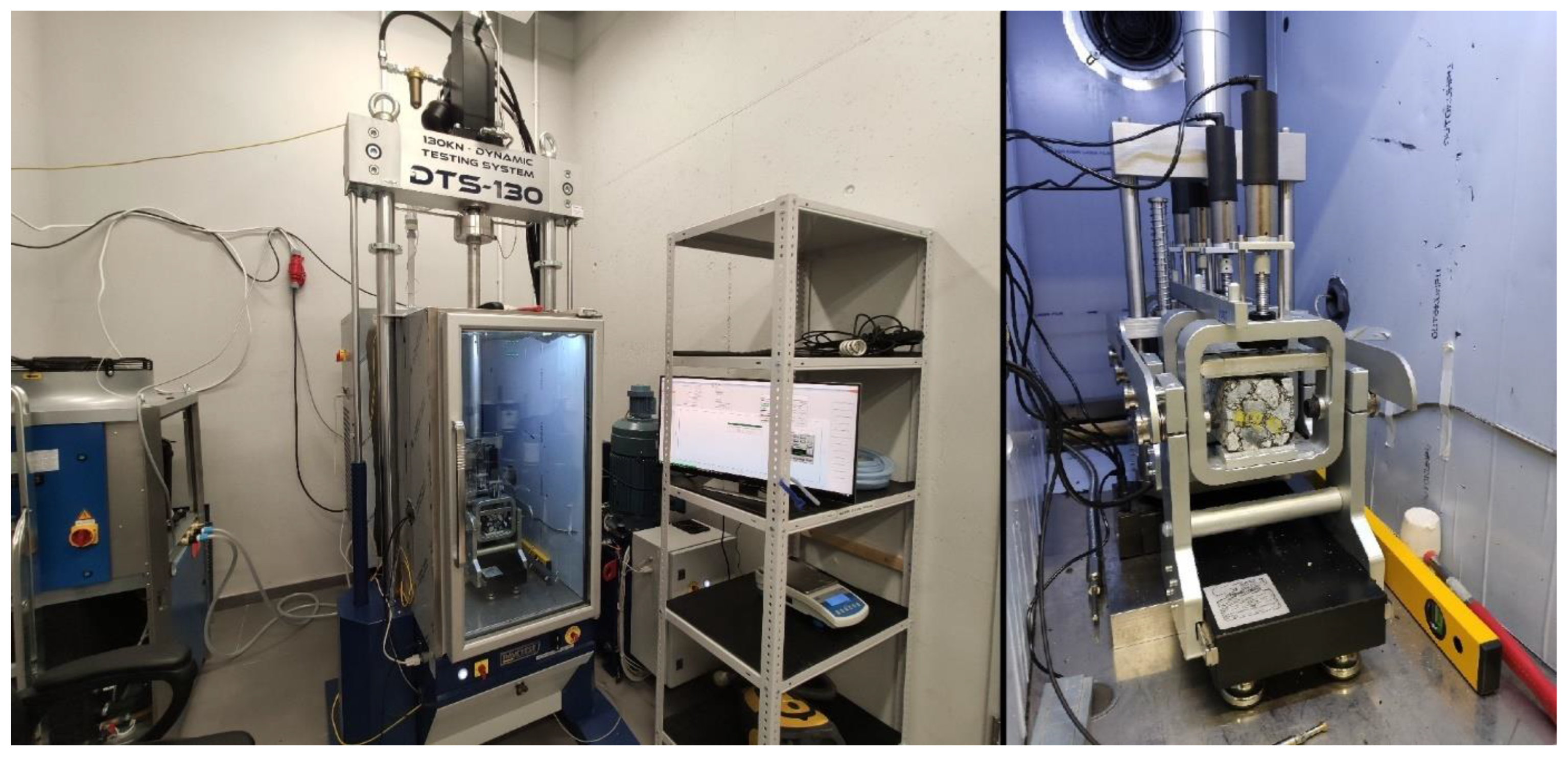
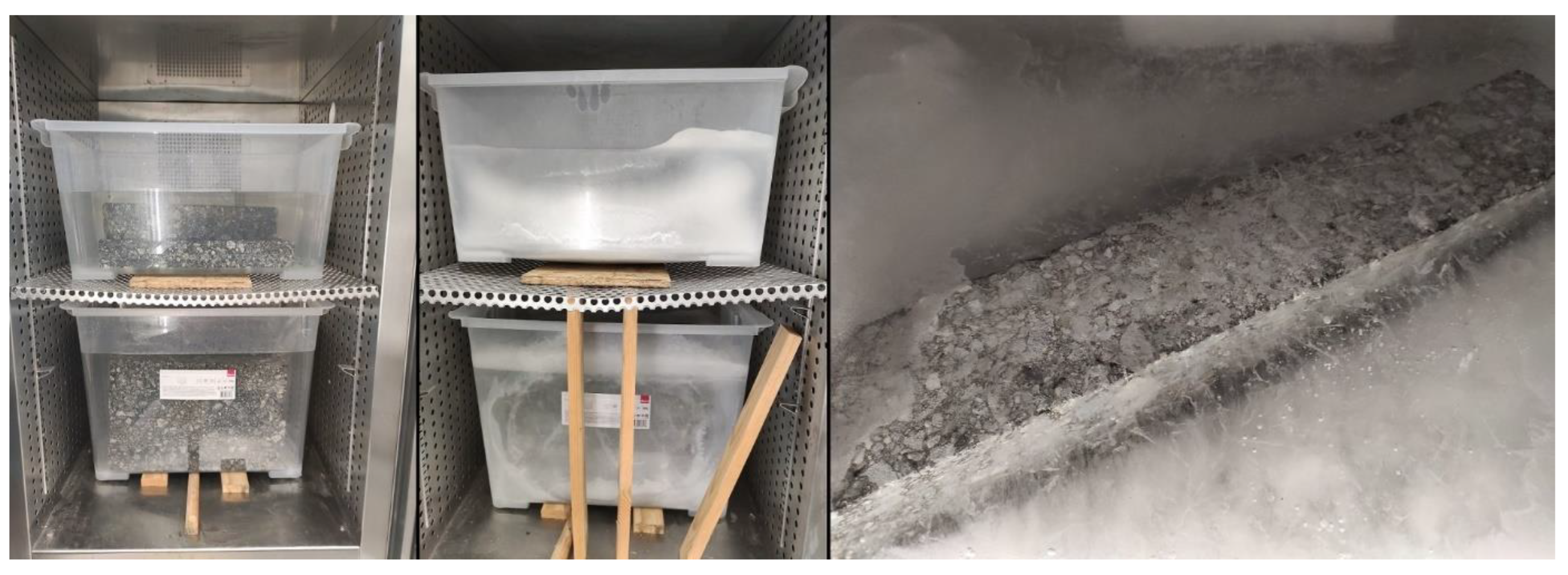
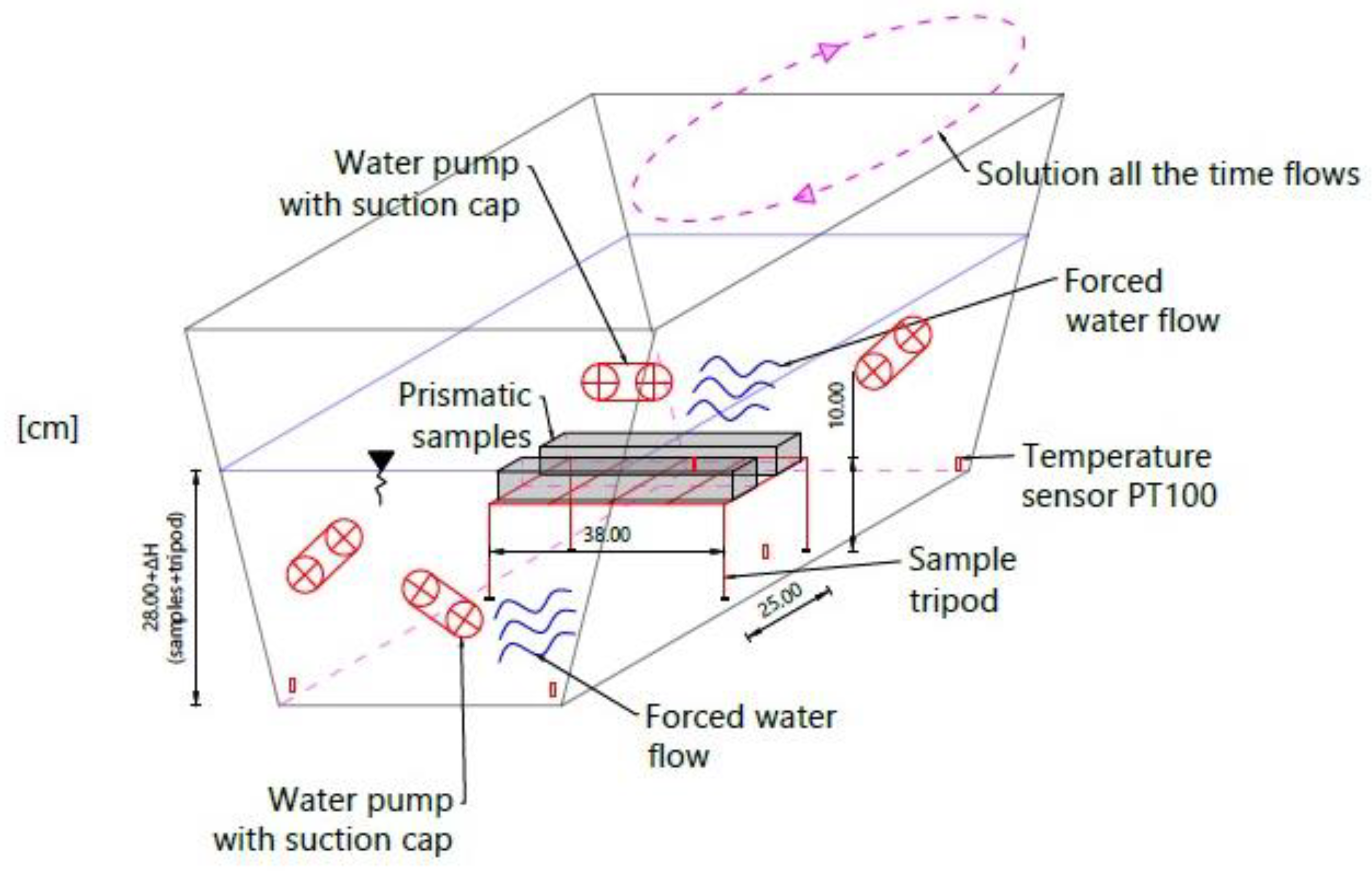
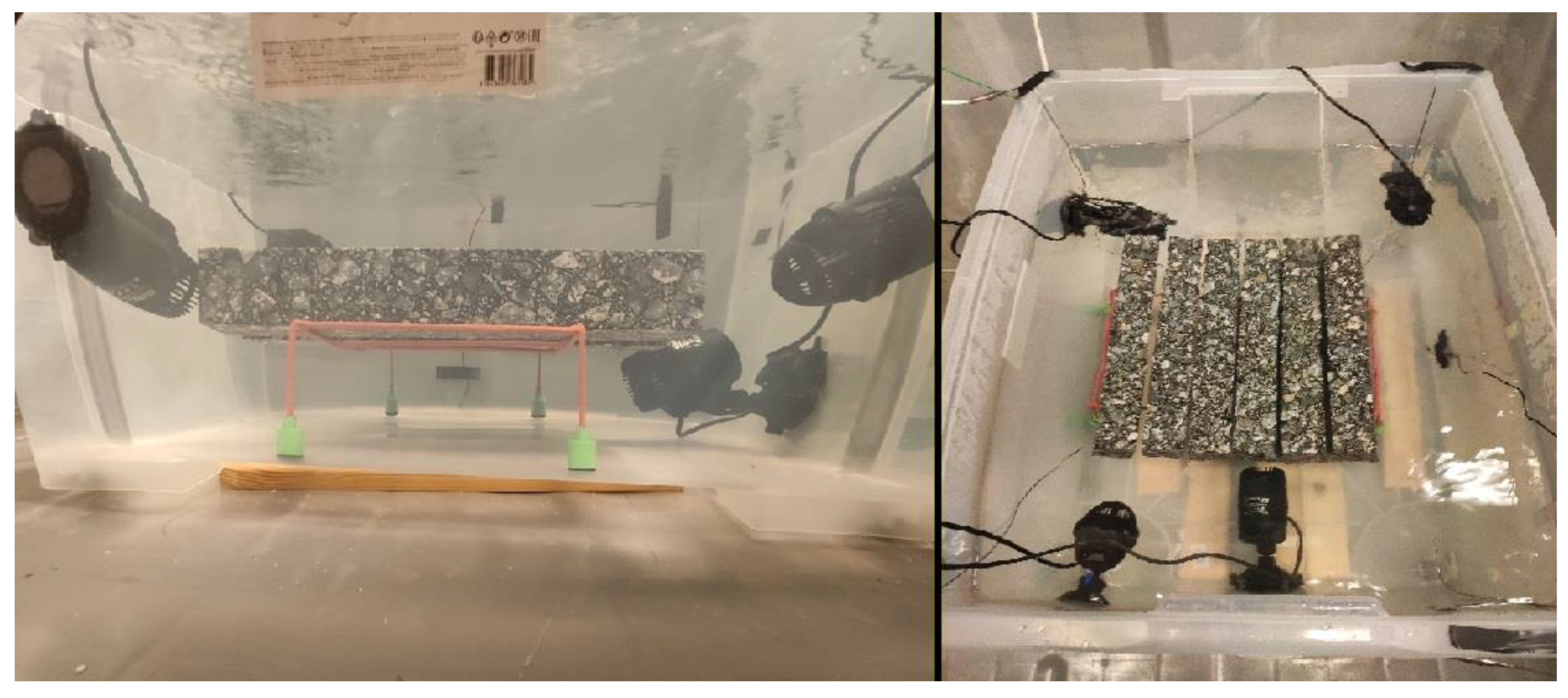
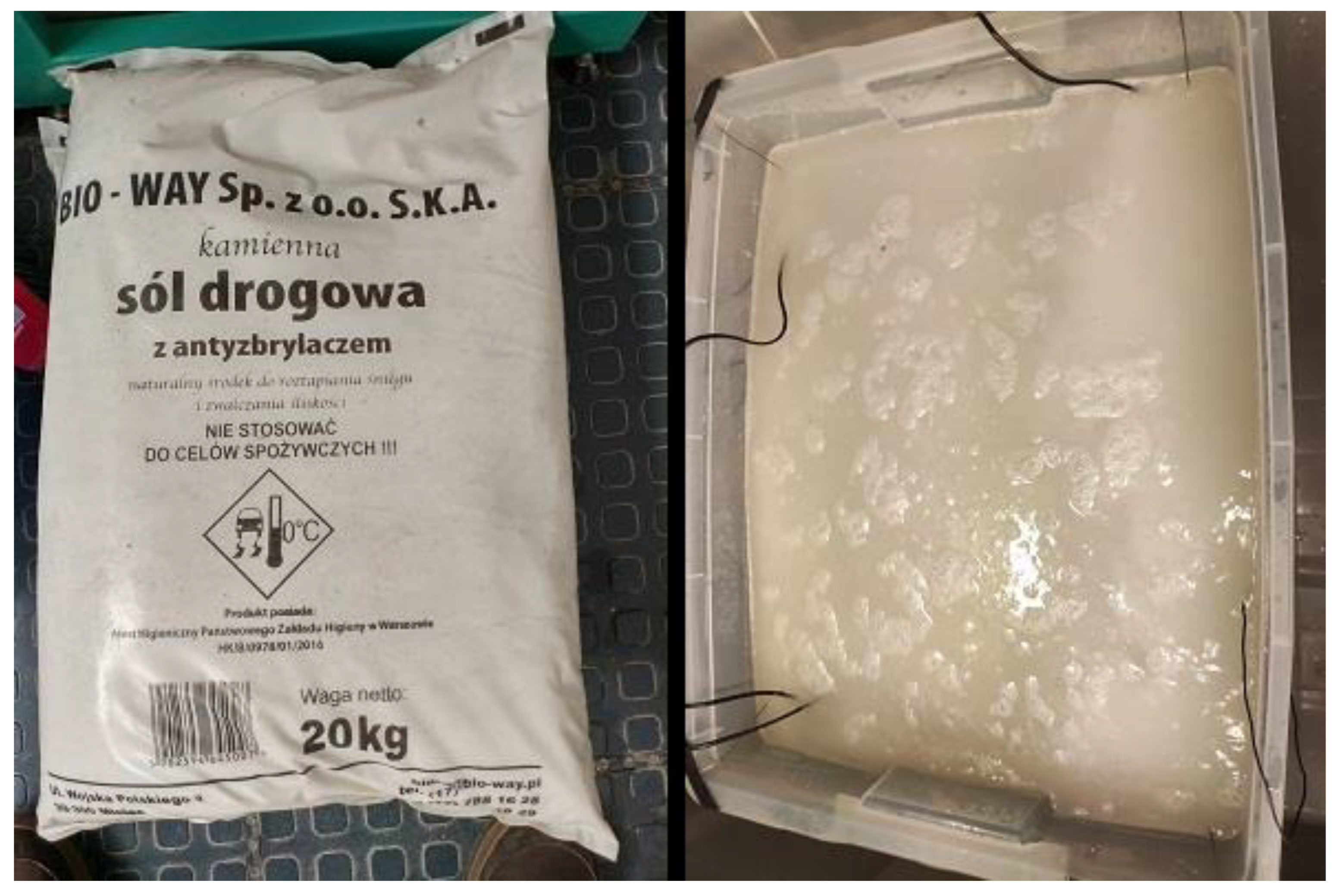

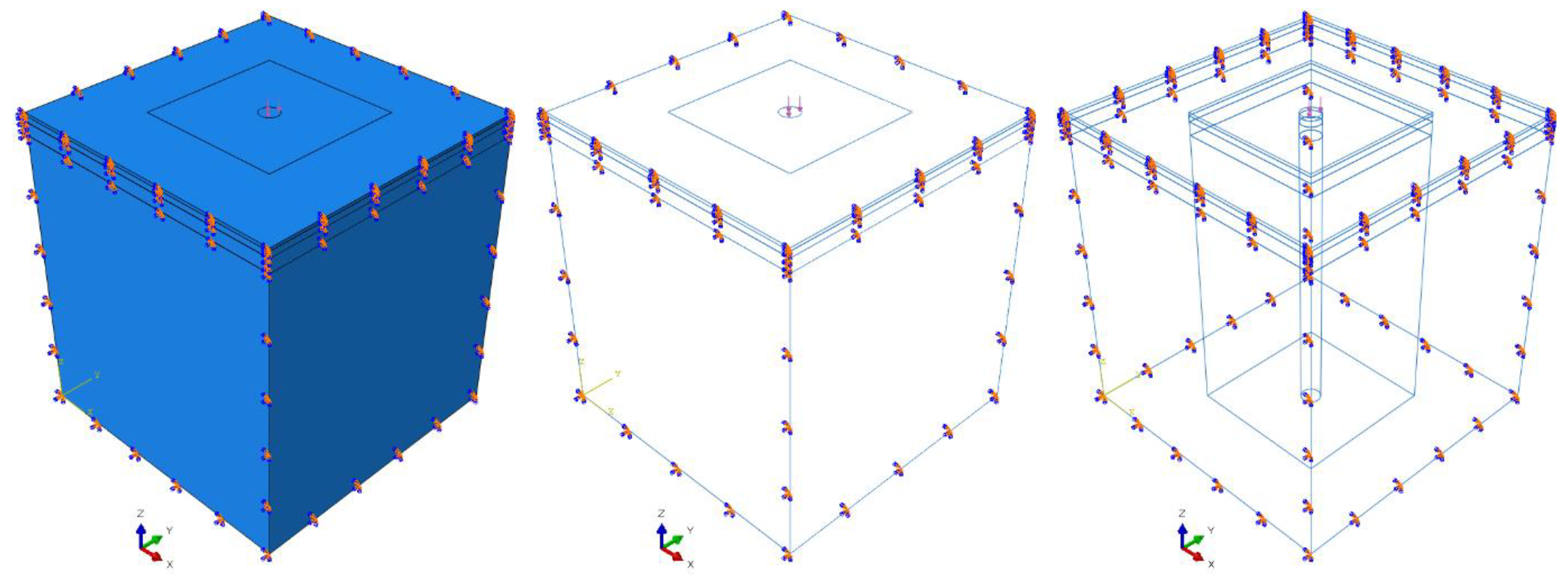
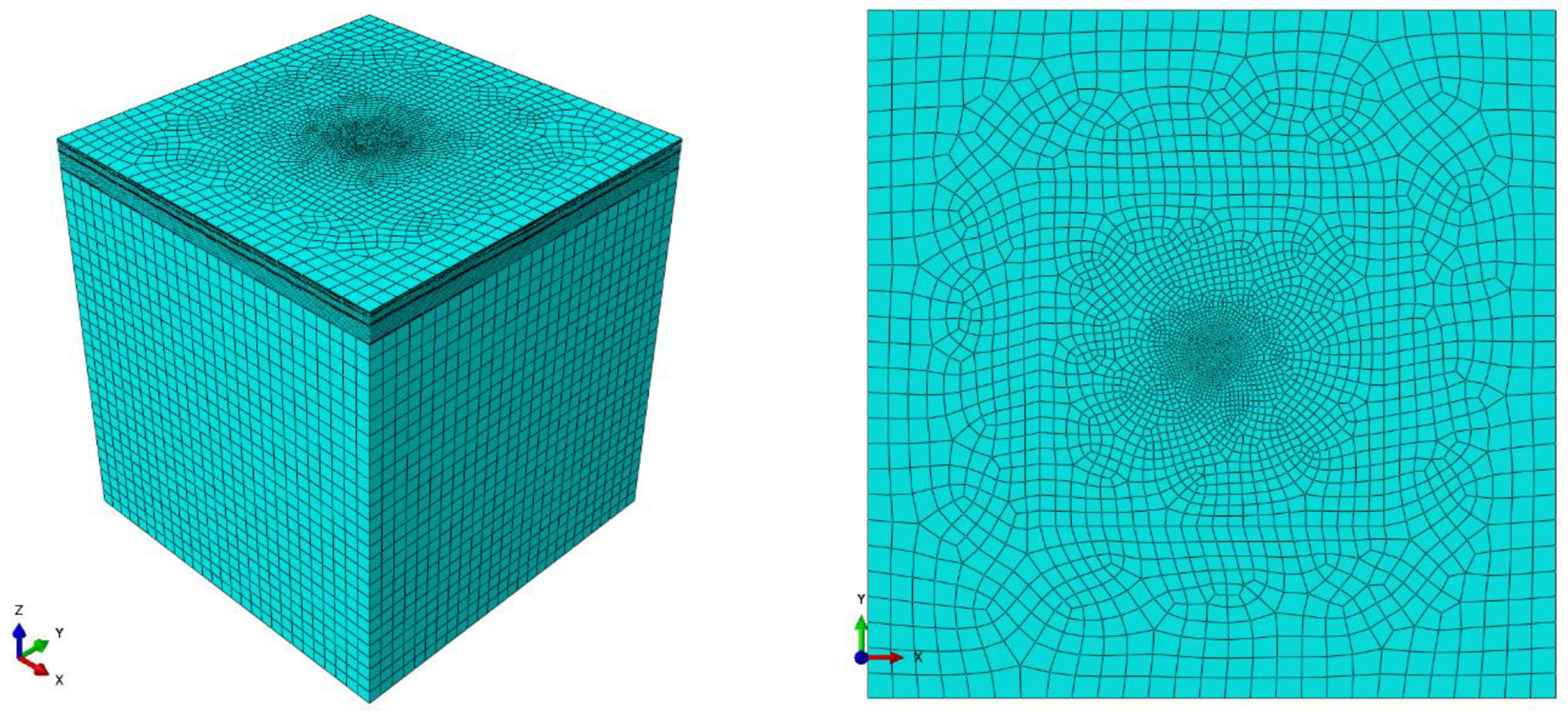
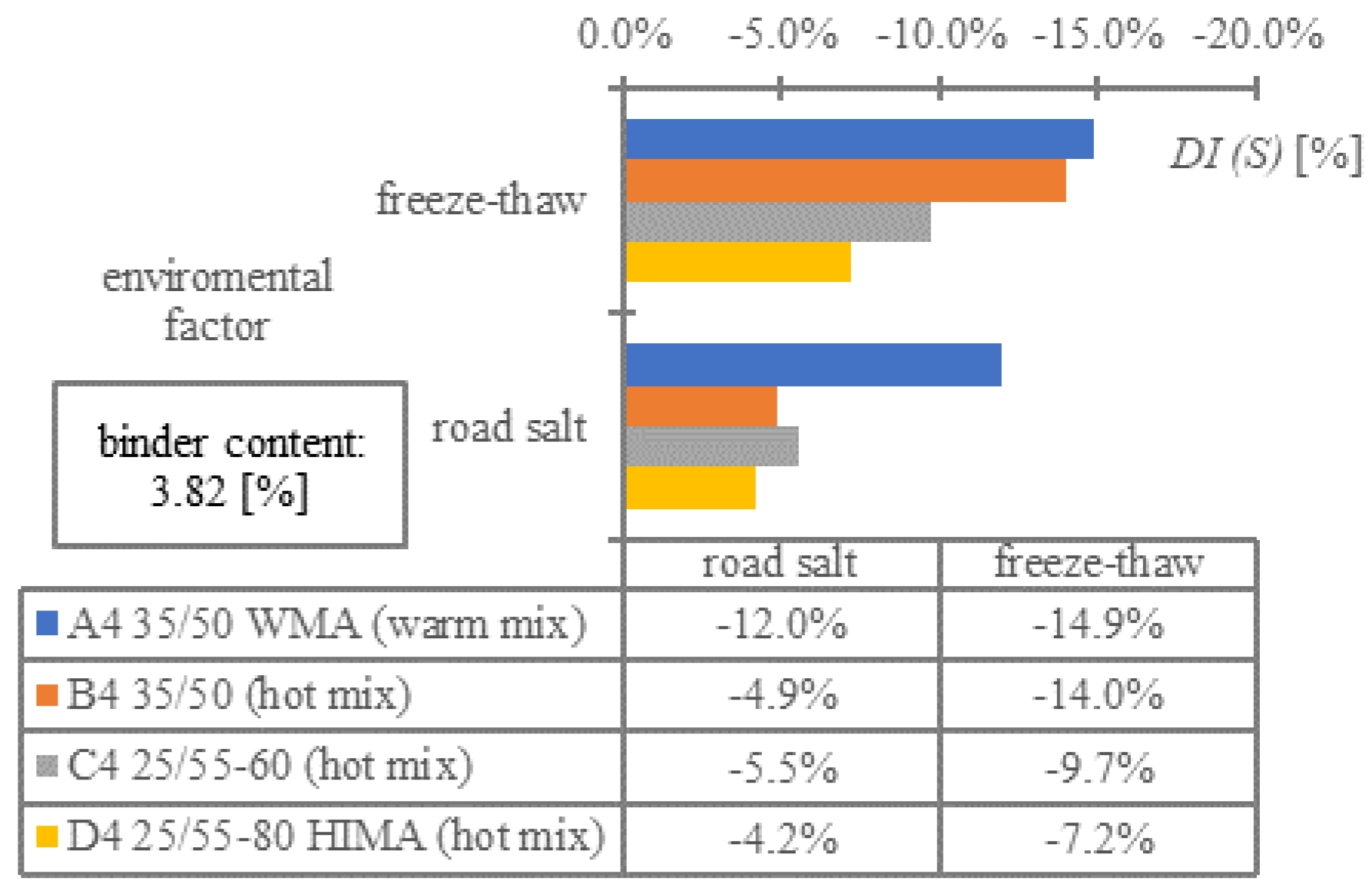
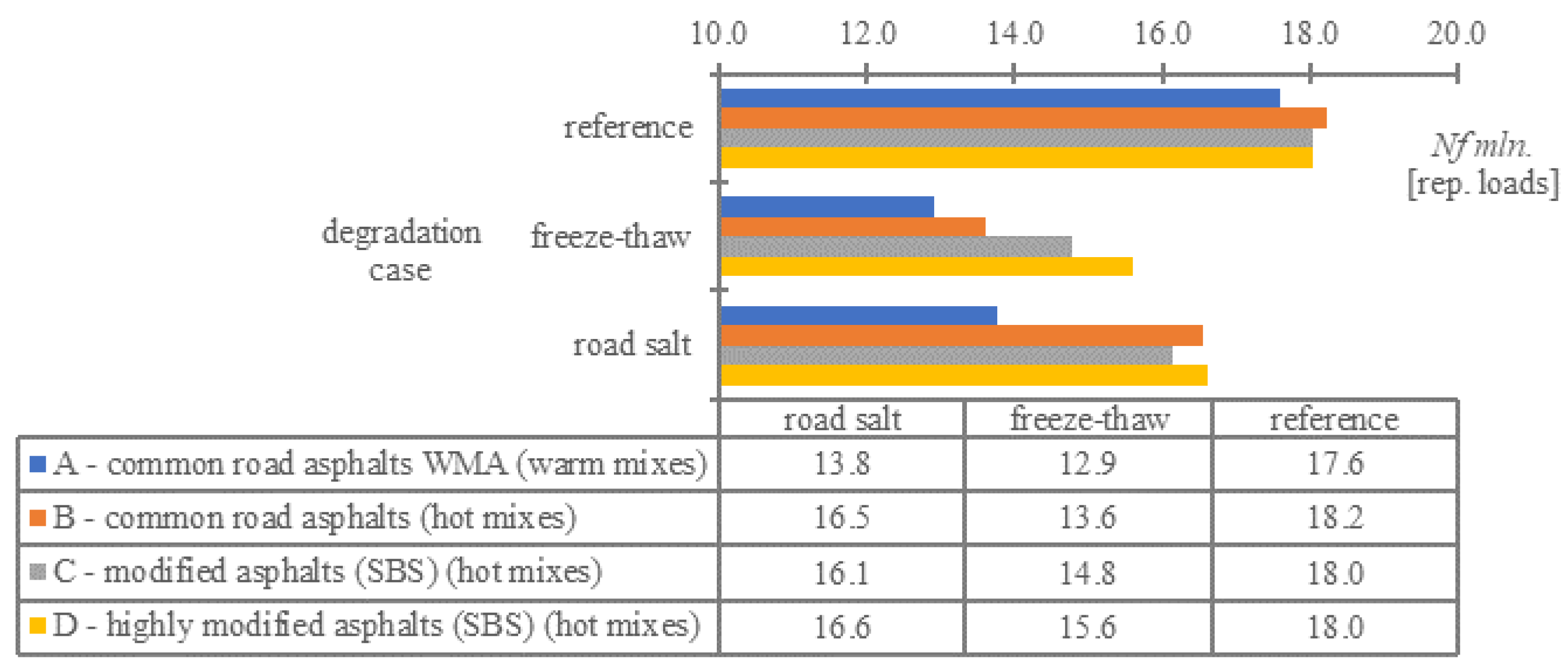
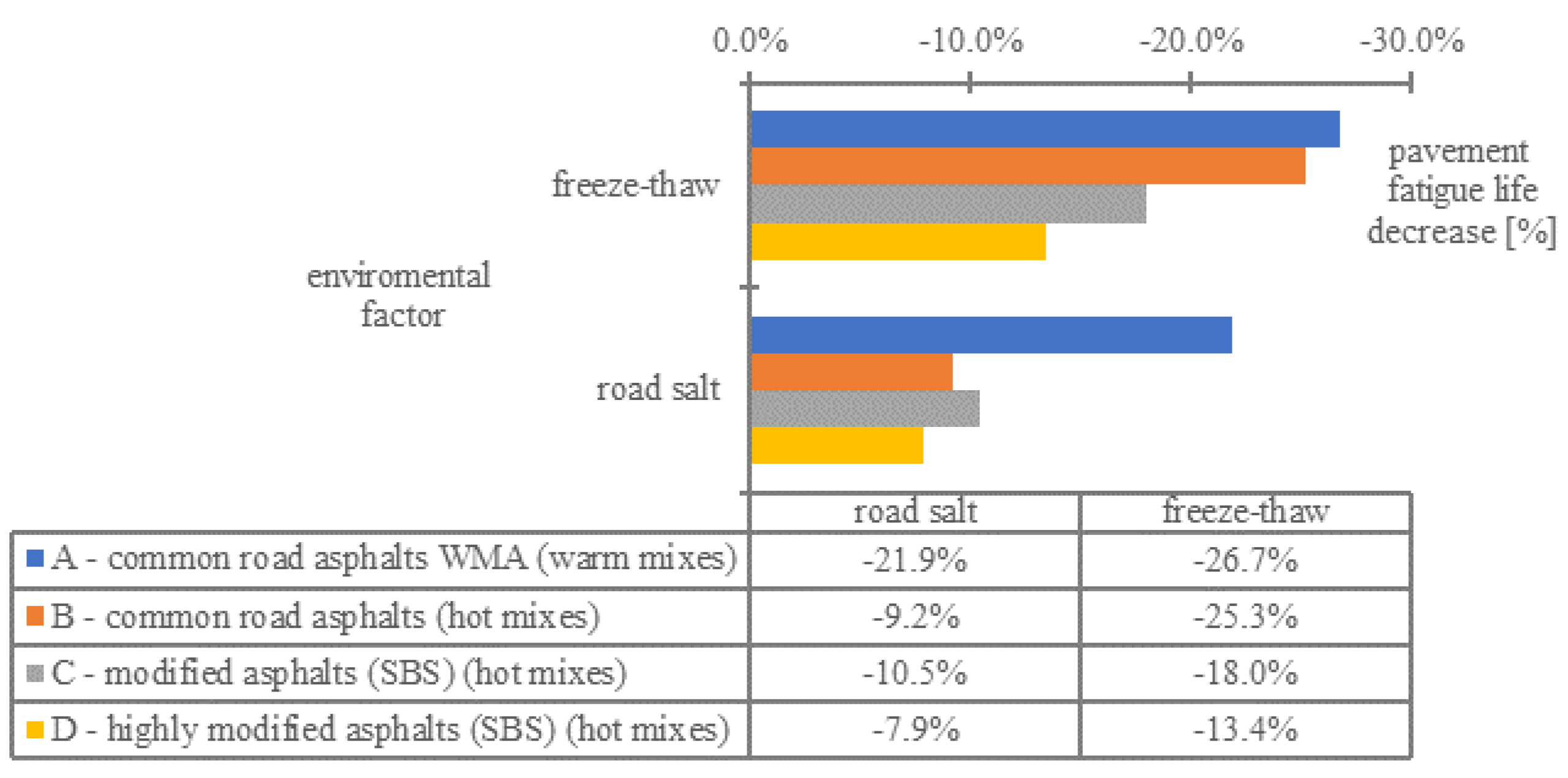
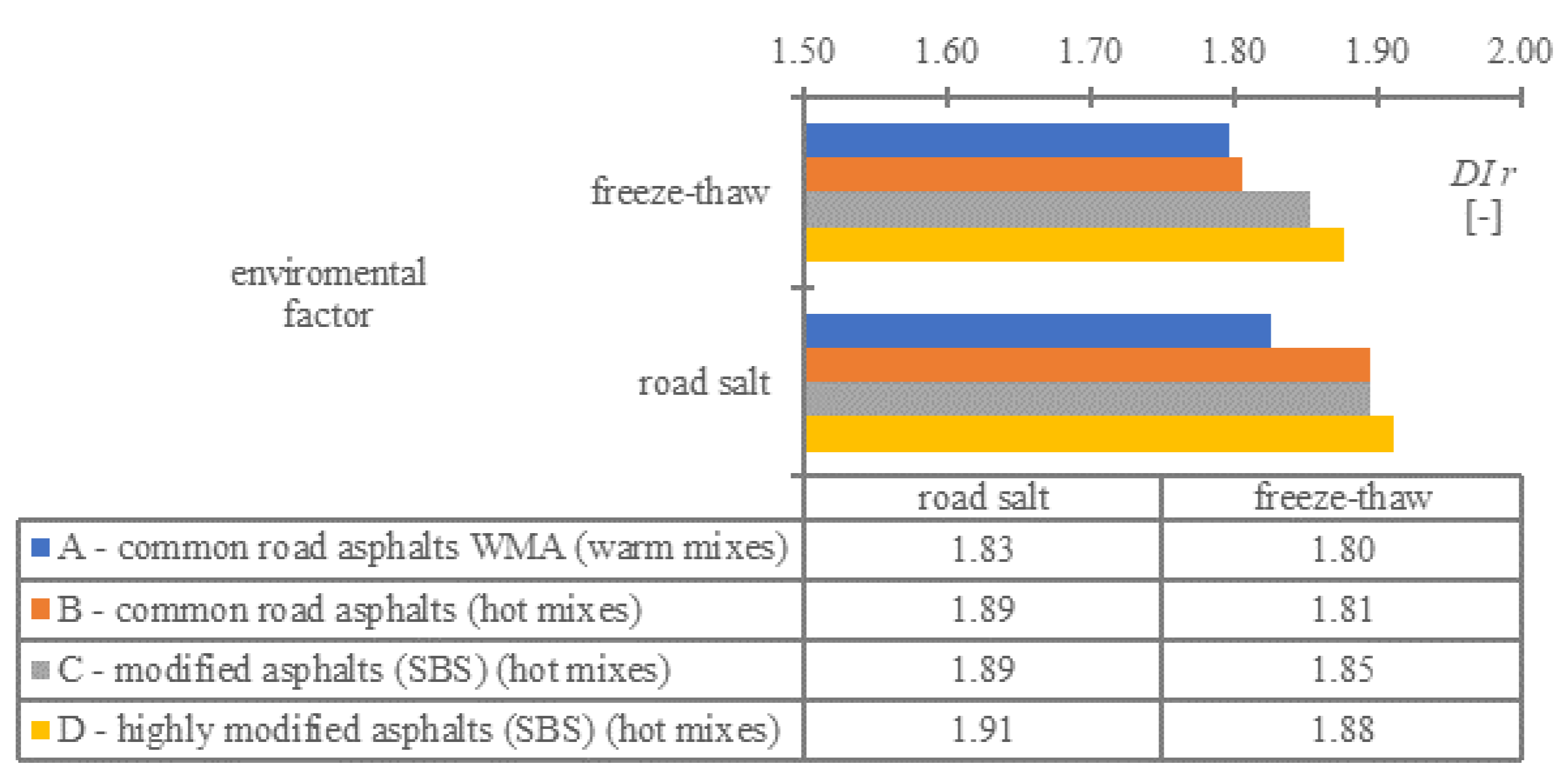
| Mix Type | Mix Destination | Mineral Mix Composition | Binder Type | Binder Content |
|---|---|---|---|---|
| AC 22 | binder course base course | 16/22 gabbro grit–31.0% 11/16 gabbro grit–7.0% 8/11 gabbro grit–10.0% 4/8 gabbro grit–10.0% 2/5 gabbro grit–16.0% 0/2 gabbro crushed sand–18.0% 0/1 milled stone extender–8.0% | 35/50 WMA (common road asphalt) 35/50 (common road asphalt) 25/55–60 (modified asphalt, polymer SBS) 25/55–80 HIMA (highly modified asphalt, polymer SBS) | 1 identical level was analyzed for each binder type: 3.82% |
| Test Condition | Property | References |
|---|---|---|
| static diagram | 4-PB-PR | PN-EN 13108-1:2016-07 [47] PN-EN 13108-20:2016-07 [48] WT-2 [29] Mackiewicz [50] |
| load diagram | cyclically determined | |
| load cycle type | oscillatory cycle | |
| impulsive load shape | sinusoidal | |
| load condition | controlled displacement | |
| frequency | constant, | |
| temperature | constant, | PN-EN 13108-1:2016-07 [47] PN-EN 13108-20:2016-07 [48] WT-2 [29] Sybilski [51] Judycki [52] Pszczoła [53] Leszczyńska [54] Haponiuk [55] Mączka [56] |
| Mix | Binder Type | Variant | |||||
|---|---|---|---|---|---|---|---|
| A4 | 35/50 WMA | 3.82% | 6.22% | ref | 9987 | 9987 | |
| f-t | 9948 | 8468 | −14.87% | ||||
| rs | 9400 | 8274 | −11.99% | ||||
| B4 | 35/50 | 3.82% | 5.00% | ref | 10,136 | 10,136 | |
| f-t | 10,096 | 8684 | −13.99% | ||||
| rs | 10,614 | 10,099 | −4.85% | ||||
| C4 | 25/55-60 | 3.82% | 5.59% | ref | 9927 | 9927 | |
| f-t | 9016 | 8137 | −9.74% | ||||
| rs | 9535 | 9007 | −5.54% | ||||
| D4 | 25/55-80 HIMA | 3.82% | 5.77% | ref | 9836 | 9836 | |
| f-t | 10,166 | 9438 | −7.16% | ||||
| rs | 10,141 | 9720 | −4.15% |
| Value | |
|---|---|
| Force shape | circle |
| Radius [m] | 0.1368 |
| Contact area [m2] | 0.0588 |
| Contact pressure [kPa] | 977.5 |
| Layer-to-layer interaction | full |
| Traffic Category | Mix | Variant | Layer | Thickness [m] | Raw Layer Stiffness Modulus [MPa] | Poisson Coefficient [-] | Layer Stiffness after Degradation [MPa] | Max. Micro-Strain Level [-] | |
|---|---|---|---|---|---|---|---|---|---|
| KR5 | A4 | ref | surface course | 0.04 | 7300 | 0.30 | −40.67 | ||
| ref | intermediate course | 0.08 | 10,300 | 0.30 | 6.297 | ||||
| ref | base course | 0.18 | 9800 | 0.30 | 59.17 | ||||
| ref | subgrade | 4.00 | 120 | 0.35 | 3.161 | ||||
| f-t | surface course | 0.04 | 7300 | 0.30 | −14.87% | 6214 | −46.38 | ||
| f-t | intermediate course | 0.08 | 10300 | 0.30 | −14.87% | 8768 | 7.794 | ||
| f-t | base course | 0.18 | 9800 | 0.30 | −14.87% | 8342 | 67.45 | ||
| f-t | subgrade | 4.00 | 120 | 0.35 | 3.408 | ||||
| rs | surface course | 0.04 | 7300 | 0.30 | −11.99% | 6425 | −45.14 | ||
| rs | intermediate course | 0.08 | 10300 | 0.30 | −11.99% | 9066 | 7.459 | ||
| rs | base course | 0.18 | 9800 | 0.30 | −11.99% | 8625 | 65.65 | ||
| rs | subgrade | 4.00 | 120 | 0.35 | 3.357 | ||||
| B4 | ref | surface course | 0.04 | 7300 | 0.30 | −40.67 | |||
| ref | intermediate course | 0.08 | 10,300 | 0.30 | 6.297 | ||||
| ref | base course | 0.18 | 9800 | 0.30 | 59.17 | ||||
| ref | subgrade | 4.00 | 120 | 0.35 | 3.161 | ||||
| f-t | surface course | 0.04 | 7300 | 0.30 | −13.99% | 6279 | −46.05 | ||
| f-t | intermediate course | 0.08 | 10,300 | 0.30 | −13.99% | 8859 | 7.688 | ||
| f-t | base course | 0.18 | 9800 | 0.30 | −13.99% | 8429 | 66.89 | ||
| f-t | subgrade | 4.00 | 120 | 0.35 | 3.393 | ||||
| rs | surface course | 0.04 | 7300 | 0.30 | −4.85% | 6946 | −42.36 | ||
| rs | intermediate course | 0.08 | 10,300 | 0.30 | −4.85% | 9800 | 6.728 | ||
| rs | base course | 0.18 | 9800 | 0.30 | −4.85% | 9324 | 61.62 | ||
| rs | subgrade | 4.00 | 120 | 0.35 | 3.238 | ||||
| C4 | ref | surface course | 0.04 | 7300 | 0.30 | −40.67 | |||
| ref | intermediate course | 0.08 | 10,300 | 0.30 | 6.297 | ||||
| ref | base course | 0.18 | 9800 | 0.30 | 59.17 | ||||
| ref | subgrade | 4.00 | 120 | 0.35 | 3.161 | ||||
| f-t | surface course | 0.04 | 7300 | 0.30 | −9.74% | 6589 | −44.23 | ||
| f-t | intermediate course | 0.08 | 10,300 | 0.30 | −9.74% | 9297 | 7.214 | ||
| f-t | base course | 0.18 | 9800 | 0.30 | −9.74% | 8845 | 64.33 | ||
| f-t | subgrade | 4.00 | 120 | 0.35 | 33.19 | ||||
| rs | surface course | 0.04 | 7300 | 0.30 | −5.54% | 6896 | −42.61 | ||
| rs | intermediate course | 0.08 | 10,300 | 0.30 | −5.54% | 9729 | 6.791 | ||
| rs | base course | 0.18 | 9800 | 0.30 | −5.54% | 9257 | 61.99 | ||
| rs | subgrade | 4.00 | 120 | 0.35 | 3.249 | ||||
| D4 | ref | surface course | 0.04 | 7300 | 0.30 | −40.67 | |||
| ref | intermediate course | 0.08 | 10,300 | 0.30 | 6.297 | ||||
| ref | base course | 0.18 | 9800 | 0.30 | 59.17 | ||||
| ref | subgrade | 4.00 | 120 | 0.35 | 3.161 | ||||
| f-t | surface course | 0.04 | 7300 | 0.30 | −7.16% | 6777 | −43.22 | ||
| f-t | intermediate course | 0.08 | 10,300 | 0.30 | −7.16% | 9562 | 6.949 | ||
| f-t | base course | 0.18 | 9800 | 0.30 | −7.16% | 9098 | 62.87 | ||
| f-t | subgrade | 4.00 | 120 | 0.35 | 3.276 | ||||
| rs | surface course | 0.04 | 7300 | 0.30 | −4.15% | 6997 | −42.11 | ||
| rs | intermediate course | 0.08 | 10,300 | 0.30 | −4.15% | 9872 | 6.661 | ||
| rs | base course | 0.18 | 9800 | 0.30 | −4.15% | 9393 | 61.26 | ||
| rs | subgrade | 4.00 | 120 | 0.35 | 3.227 |
| Mix | Binder Type | Variant | Fatigue Life Trend Regarding to Reference | |||||||||
|---|---|---|---|---|---|---|---|---|---|---|---|---|
| AC22 | 35/50 WMA | 9.6% | 6.2% | ref | 0.0% | 9800 | 59.17 | 17.6 | ||||
| f-t | −14.9% | 8342 | 67.45 | 12.9 | −4.7 | −26.7% | 1.80 | decrease | ||||
| rs | −12.0% | 8625 | 65.65 | 13.8 | −3.9 | −21.9% | 1.83 | decrease | ||||
| 35/50 | 9.8% | 6.2% | ref | 0.0% | 9800 | 59.17 | 18.2 | |||||
| f-t | −14.0% | 8429 | 66.89 | 13.6 | −4.6 | −25.3% | 1.81 | decrease | ||||
| rs | −4.9% | 9324 | 61.62 | 16.5 | −1.7 | −9.2% | 1.89 | decrease | ||||
| 25/55-60 | 9.7% | 6.2% | ref | 0.0% | 9800 | 59.17 | 18.0 | |||||
| f-t | −9.7% | 8845 | 64.33 | 14.8 | −3.3 | −18.0% | 1.85 | decrease | ||||
| rs | −5.5% | 9257 | 61.99 | 16.1 | −1.9 | −10.5% | 1.89 | decrease | ||||
| 25/55-80 HIMA | 9.7% | 6.2% | ref | 0.0% | 9800 | 59.17 | 18.0 | |||||
| f-t | −7.2% | 9098 | 62.87 | 15.6 | −2.4 | −13.4% | 1.88 | decrease | ||||
| rs | −4.2% | 9393 | 61.26 | 16.6 | −1.4 | −7.9% | 1.91 | decrease |
Publisher’s Note: MDPI stays neutral with regard to jurisdictional claims in published maps and institutional affiliations. |
© 2022 by the authors. Licensee MDPI, Basel, Switzerland. This article is an open access article distributed under the terms and conditions of the Creative Commons Attribution (CC BY) license (https://creativecommons.org/licenses/by/4.0/).
Share and Cite
Mączka, E.; Mackiewicz, P. Asphalt Mixtures and Flexible Pavement Construction Degradation Considering Different Environmental Factors. Appl. Sci. 2022, 12, 12068. https://doi.org/10.3390/app122312068
Mączka E, Mackiewicz P. Asphalt Mixtures and Flexible Pavement Construction Degradation Considering Different Environmental Factors. Applied Sciences. 2022; 12(23):12068. https://doi.org/10.3390/app122312068
Chicago/Turabian StyleMączka, Eryk, and Piotr Mackiewicz. 2022. "Asphalt Mixtures and Flexible Pavement Construction Degradation Considering Different Environmental Factors" Applied Sciences 12, no. 23: 12068. https://doi.org/10.3390/app122312068
APA StyleMączka, E., & Mackiewicz, P. (2022). Asphalt Mixtures and Flexible Pavement Construction Degradation Considering Different Environmental Factors. Applied Sciences, 12(23), 12068. https://doi.org/10.3390/app122312068







